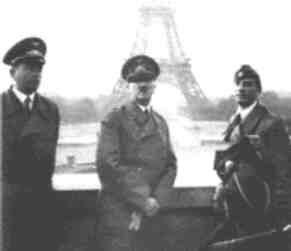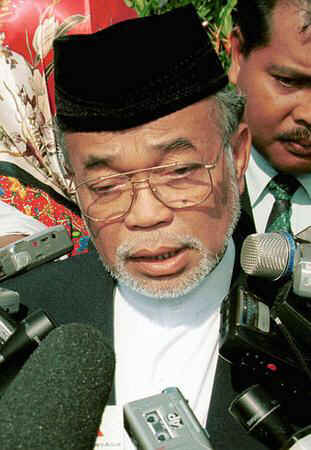1858 Edgardo
Mortara, 6, is “kidnapped” by order of the Pope..
^top^
The
papal police enter the home of Shlomo Mortara, a Jewish merchant living
in Bologna, Papal States, and remove the Mortara's little Edgardo.
Some years earlier, a servant girl in the Mortara household, fearing
that Edgardo was on the verge of death, had baptized him. This made
him a Catholic, who could not be brought up properly by Jews, be they
his parents. So Pope Pius
IX, disregarding an international outcry, adopts the boy and has
him raised a Catholic. Edgardo became quite attached to Pius IX and
became a Catholic priest, who labored for the conversion of Jews.
He died an the abbey in Bouhay, Belgium, in March 1940.
The scandal was stirred up again in 2000, when Pope John Paul II decided
to beatify Pius IX on 03 September. This prompted some to say that
Pius IX would be the patron saint of kidnappers (presumably if canonization
were to follow in due course). There was considerable opposition to
the beatification of Pius IX, not only for this reason, but for a
variety of others, including his discriminatory treatment of Jews,
his opposition to the unification of Italy, his Syllabus of Errors,
and his promotion of the doctrine of papal infallibility.
The
case was the subject of David Kertzer's 1997 book The Kidnapping
of Edgardo Mortara: The Extraordinary Story of How a Jewish Child,
Made a Prisoner of the Vatican in 1858, Ended the Rule of the Popes
in Italy. |
1848 Bloody insurrection of workers in Paris
1845 Texas
votes for Annexation to US. ^top^
After ten years as an independent republic,
the Congress of the Republic of Texas votes to accept annexation by
the United States. Texas had already voted for annexation once before,
in 1836; however, the likelihood of Texas joining the Union as a slave
state delayed any formal action by the US Congress for over a decade.
After gaining independence from Spain
in the 1820s, Mexico welcomed foreign settlers to sparsely populated
Texas, and a large group of Americans led by Stephen F. Austin settled
along the Brazos River. The Americans soon outnumbered the resident
Mexicans, and by the 1830s attempts by the Mexican government to regulate
these semi-autonomous American communities led to rebellion.
In March of 1836, in the midst of armed
conflict with the Mexican government, Texas declared its independence
from Mexico. The Texas volunteers initially suffered defeat against
the forces of Santa Anna-- the Alamo fell (06 March 1836) and Sam
Houston's troops were forced into an eastward retreat. However, in
late April, Houston's troops surprised a Mexican force at San Jacinto
(21 April 1836) and Santa Anna was captured, bringing an end to Mexico's
effort to subdue Texas. In exchange for his freedom, Santa Anna recognized
Texas' independence, although the treaty was later abrogated and tensions
built up along the Texas-Mexico border.
The citizens of the so-called "Lone Star Republic" elected Sam Houston
as president, but also endorsed the entrance of Texas into the Union.
However, Congress feared that Texas would shift the balance of power
between the North and South, and the Republic of Texas remained independent
for nine years. Finally, in 1844, Secretary of State John C. Calhoun
orchestrated a compromise in which Texas would join the United States
as a slave territory. Four months after the approval of formal annexation
of Texas by the US Congress, Texas' congress accepted US statehood.
On 29 December 1845, Texas entered the United States as a slave state,
broadening the irrepressible differences in the US over the issue
of slavery and igniting the Mexican-American War (April 1846-February
1848). |
1810 One more company for fur
tycoon ^top^
German-born merchant John Jacob Astor,
46, strengthens his grip on America's burgeoning fur industry by establishing
the Pacific Fur Company (Astoria, Oregon). The founding of Pacific
Fur came but two years after Astor incorporated the American Fur Company.
A hard-driving businessman, Astor had already established a toe-hold
in the industry in the late 1700s; with the founding of American Fur,
he became one of the kings of the fur trade. Indeed, American Fur
quickly established choke holds over the Missouri River valley, as
well as the Rocky Mountains and Great Lakes regions.
But, Astor was a prototypical American entrepreneur and thus looked
to expand his domain. Pacific Fur was born of these cutthroat commercial
instincts, most notably Astor's desire to conquer the Pacific Northwest.
Moreover, in 1811, Astor used Pacific Fur to found the village-cum-trading
post of Astoria, which was designed to facilitate the fur maven's
exchanges with China. However, Astor's hopes for Astoria were soon
dashed: the village, nestled near the Columbia River, was a casualty
of the War of 1812. The loss hardly deterred Astor, who continued
to rule the fur trade until 1834, when he left the business to attend
to his fortune. |
1789 Par la volonté du Peuple! C’est au cours d’une des
sessions des Etats Généraux, que Mirabeau (Gabriel Honoré Riquetti, comte
de Mirabeau) lancera au "Maître de Cérémonies du Roi" venu pour faire évacuer
la salle cette superbe réplique : "Allez dire à votre maître que nous sommes
ici par la volonté du peuple et que nous n’en sortirons que par la force
des baïonnettes" !
1784 first US balloon flight
(13 year old Edward Warren)
1760 Battle of Landshut,
Silesia
1743 Bataille de Bettingen. C'est la guerre
de Succession d'Autriche. Les Anglais débarquent à Hanovre. George III,
roi d'Angleterre, défait Adrien Maurice, comte d'Ayen, et troisième duc
de Noailles.
1683 William Penn signs friendship
treaty with Lenni Lenape indians in Pennsylvania; only treaty "not sworn
to, nor broken" . Voltaire once remarked that it was the only treaty never
sworn to, and never broken.
1611 Hudson
set adrift by mutineers ^top^
After spending a winter trapped in
present-day Hudson Bay by ice, the starving crew of the Discovery
mutinies against its captain, English navigator Henry Hudson, 46,
and set him, his teenage son, and seven supporters adrift in a small,
open boat. They were never seen again.
Two years earlier, in 1609, after repeatedly failing in his efforts
to find a northeast ocean passage to Asia, Hudson
sailed to the Americas to find a northwest passage. Exploring the
North American coast, he entered the present-day Chesapeake, Delaware,
and New York bays, and then became the first European to ascend what
is now called the Hudson River. His voyage, which was financed by
the Dutch, was the basis of Holland’s later claims to the region.
His fourth expedition, financed by
adventurers from his own country, set out from London, England, on
17 April 1610. Sailing back across the Atlantic, Hudson resumed his
efforts to find the northwest passage. Between Greenland and Labrador
he entered present-day Hudson Strait and by it reached Hudson Bay.
After three months of exploration, the Discovery was caught too far
from open sea when winter set in, and in November Hudson’s men were
forced to haul it ashore and set up a winter camp. Lacking food or
supplies, the expedition greatly suffered in the extreme cold.
Many of the crew held Hudson responsible
for their misfortune, and on 23 June 1611, with the coming of summer,
they mutinied against him. The Discovery later returned to England,
and its crew was arrested and convicted for the mutiny. Although Henry
Hudson was never seen again, his discoveries gave England its claim
to the rich Hudson Bay region. |
1173 Révoltés contre leur père, Henry II d'Angleterre,
Henri le Jeune, Richard, et Geoffroy, aidés moralement par leur mère Eléanore
d'Aquitaine, et aussi soutenus par Louis
VII, roi de France, mettent le siège devant Verneuil.
0079 Titus
Flavius Vespasianus empereur
^top^
Son père, Vespasien,
avait succédé à Néron
après que plusieurs chefs militaires se furent âprement disputé le
trône. Son règne presque pacifique (69 - 79) vit les débuts de l'édification
du Colisée, l'un des plus grandioses monuments de la Rome antique,
ainsi que la conquête de l'Angleterre. Le 23 Juin 79, accède
à la pourpre impériale de Titus, le fils de Vespasien, le vainqueur
des Juifs, commandant en chef de l’Armée Romaine,. Titus Flavius Vespasianus,
39 ans. L’empereur que l’on surnomma "les délices du genre humain"
régna à peine plus de deux ans. Mais il a laissé une empreinte positive.
Il avait d’abord secondé son père pendant
la guerre contre les Juifs (prise de Jérusalem en 70) puis, quand
Vespasien partit pour Rome prendre le pouvoir, il avait commandé en
chef l’armée romaine, ce qui lui valut les honneurs d’un triomphe
qui a été sculpté sur l’arc dit de Titus, au Forum romain. On connaît
ses amours avec Bérénice (Racine); ils sont secondaires.
En tant que souverain, il se conduisit comme un vrai monarque : il
écarta Domitien, vénéra des divinités orientales qui renforçaient
le culte impérial (Isis), et il agit en tout avec une prodigalité
et un luxe digne des souverains-dieux d'Orient. Mais, pour montrer
son sens de la mesure et apaiser le Sénat, il fit poursuivre les délateurs
et refusa les procès contre les crimes de lèse-majesté, donc contre
les Chrétiens.
Son règne fut
marqué par des catastrophes : en 79, une éruption du Vésuve détruisit
Pompéi, Herculanum, Stabies, et Torre Annunziata. En 80, Rome dut
supporter l’incendie et la peste. Dans tous les cas, l’empereur se
montra secourable ; de plus, il fit entreprendre de nombreux travaux
publics : à Rome, il laissa des thermes, un arc de triomphe (l’Arc
de Titus, encore debout à Rome), et il fit poursuivre les travaux
du Colisée ; dans les provinces, de nombreuses bornes milliaires attestent
son souci du réseau routier, notamment dans la région de Tongres (près
de Liège, en Limbourg). Il mourut le 13 septembre 81 ; les raisons
de ce décès restent encore mystérieuses.
Ah
un truc mnémotechnique pour retenir la liste des empereurs romains
du premier siècle ap. J.C. Retenez la " formule magique " :
Cesautica, Claunégalo, Vivestido. Soit en décomposant
les mots en syllabes :
César, Auguste, Tibère, Caligula, Claude, Néron, Galba, Otton, Vitellius,
Vespasien, Titus et Domitien. |
|
 On
a June 23:
On
a June 23: 

 1940
Hitler sightsees in conquered Paris
1940
Hitler sightsees in conquered Paris

 Michael Fitzpatrick, a high-school classmate of Shabazz, claimed that she
called him and asked him to kill Farrakhan. Fitzpatrick said she told him
that she wanted to avenge her father's death, and feared for the life of
her mother Betty Shabazz who was outspoken in her belief that Farrakhan
was behind the 1964 shooting. Although Farrakhan was allied with the
Michael Fitzpatrick, a high-school classmate of Shabazz, claimed that she
called him and asked him to kill Farrakhan. Fitzpatrick said she told him
that she wanted to avenge her father's death, and feared for the life of
her mother Betty Shabazz who was outspoken in her belief that Farrakhan
was behind the 1964 shooting. Although Farrakhan was allied with the